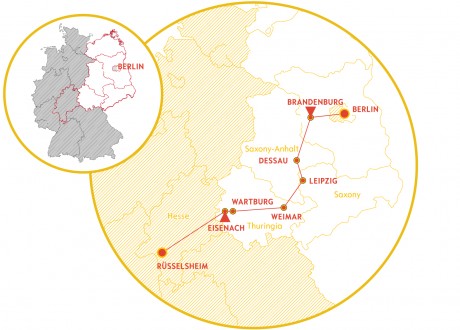
There is a piece of the Berlin Wall in Thuringia. Flatbed trucks drive past it, heavily loaded with components for manufacturing the Opel ADAM and Corsa. The fragment of concrete has found a home at the heart of the Opel plant in Eisenach and serves as a reminder of an eventful history characterized by the peaceful East German revolution, the fall of the Berlin Wall, reunification, and the beginning of a new era, and not just in Eisenach.
The Beginning of a Journey through Time
As the wheel of time turned in November 1989, a very special Opel Omega rolled off the assembly line. It was the 25 millionth Opel to be manufactured – a station wagon with a gently purring, powerful three-liter straight-six engine under the long hood. Straight-sixes like this made the Opel Blitz and Kapitän legends in engine manufacturing. Now, 25 years after it rolled off the line, the 25 millionth Opel is parked in front of a piece of the Berlin Wall in Eisenach. A magma red Corsa glistens in the evening sun next to the classic car. The high-gloss black roof and the dark 16-inch wheels perfectly suit the paintwork of the Corsa Color Edition. The fifth generation of the best seller recently celebrated its world premiere at the Paris Motor Show, going from there to Eisenach to welcome the Omega shortly thereafter. The three-door Corsa is at home today in Thuringia, as Opel began building cars again after reunification in the traditional auto manufacturing center, following in the footsteps of BMW (Dixi went on to become the BMW 3/15) and the VEB Automobilwerk Eisenach (Wartburg). Thanks to the fall of the Berlin Wall 25 years ago, Opel was able to acquire a plant in East Germany. And something else was lost 70 years before that: the truck plant in Brandenburg an der Havel. That’s why our anniversary Omega is searching for clues by traveling through five eastern states, past German monuments to the old site in Brandenburg and finally on to Berlin where the gray piece of concrete in Eisenach comes from.
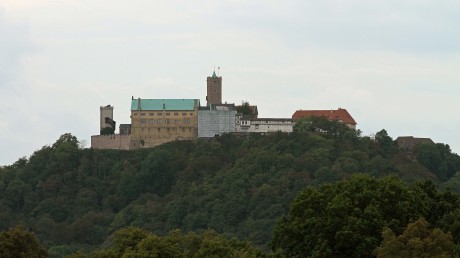
Over the hills: Martin Luther translated the Bible in Wartburg Castle and every new Opel vehicle made in Eisenach is traditionally photographed against this backdrop.
From Thuringia to Saxony
If you’re passing Eisenach, you can’t miss Wartburg Castle. It was here that Martin Luther translated the New Testament from Greek into German, ensuring that the German people could finally understand the text, not just read it. The consequences of the Reformation that followed are still highly visible in Germany today, where the south of the country is predominantly Catholic and the north is predominantly Protestant. The Omega enjoys the distant view of Wartburg Castle and the Thuringian Forest while making its way to a vintage car convention of a very special kind. The A4 motorway leads the modern classic straight to the home of the poet laureates Goethe and Schiller in Weimar. The road doesn’t quite lead to the Goethe-Schiller monument on Theatre Square, as the pair now reside in a pedestrian area, allowing Weimar to deliver an incomparable flair. The city’s residents stroll past the wonderfully restored historic façades as if they were in a Renaissance city in northern Italy. Cafés and restaurants dot the city streets, enticing visitors to enter. Weimar has been a UNESCO World Heritage site since 1998. It is the home of poets Goethe, Herder, Schiller, and Wieland and it is the city where the Bauhaus movement began and where the national assembly of the Weimar Republic convened in 1919 to mark Germany’s move towards democracy.
From Thuringia the journey continuous to the next federal state. Many German automotive companies have their roots in Saxony. The Audi, Horch, DKW, and Wanderer brands, which would later merge to form Auto Union, all settled in the Ore Mountains, or more precisely, in the cities of Chemnitz, Zschopau, and Zwickau. BMW, too, has extensive roots in Chemnitz, after growing out of the former Rapp Motorenwerke. Later, VEB Sachsenring built just one model, the Trabant, the vehicle that symbolized the fall of the Berlin Wall. The automotive industry is now back in Saxony. AMI, Germany’s second largest motor show, takes place every two years at its customary venue. BMW and Porsche opened modern new plants between the convention center and the airport after reunification, and they are joined by Volkswagen, which has sites in Chemnitz, Zwickau, and Dresden. After all, the peaceful revolution began in Saxony with the ‘Monday demonstrations’ in Leipzig. After spreading to more and more cities, the demonstrations eventually led to the collapse of the GDR.
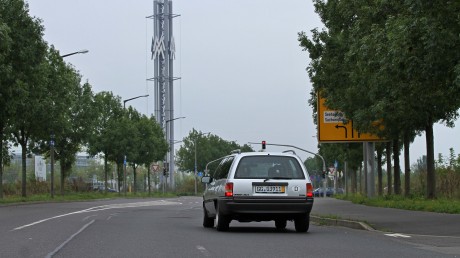
At Leipzig Trade Fair: In 1989, the Omega was the 25 millionth Opel to roll off the assembly line. That same year, the Monday demonstrations began in Leipzig and eventually led to the collapse of the GDR.
Continuing the journey to Saxony-anhalt
Opel’s automotive history actually started in Dessau as this was the birthplace of first director of the Opel vehicle plant, Friedrich Lutzmann. The Opel brothers purchased the Dessau plant from him and started producing their first car, the ‘Opel Patent Motor Car System Lutzmann’, in 1899.
Furthermore, the Bauhaus by Walter Gropius is once again a topic in Saxony-Anhalt. Searching for a liberal environment, the art school moved to the then strongly social democratic city of Dessau. It was lured in and financially supported by aircraft manufacturer Hugo Junkers. The pioneer of the design of all-metal airplanes, father of the legendary Ju 52, co-founder of Lufthansa, and inventor of the Junkers gas-fired water heater was dispossessed by the Nazis and died two years later in exile in Bavaria. The Junkers plants played an important role for Opel during the war, with Opel being called on to manufacture components in Rüsselsheim for the Ju 88 at the request of the Ministry for Weapons, Munitions, and Armament. Today, the restored Bauhaus and the Technical Museum in Dessau provide the exciting evidence of contemporary history.
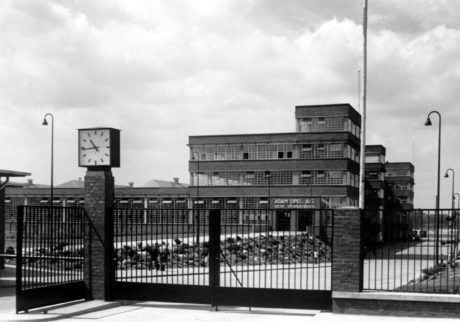
Bombed in 1944: Opel’s Brandenburg plant was constructed in Brandenburg an der Havel in just 190 days in 1935.
In Brandenburg an der Havel
The Omega 3.0i once again comes face to face with Opel history in the birthplace of Vicco von Bülow, better known as Loriot. Opel’s Brandenburg plant was constructed here in Brandenburg an der Havel in just 190 days in 1935. It was located along the south bank of the Silo Canal, directly adjacent to a steel plant and Arado Flugzeugwerke factories. Despite the rush, the resulting building was state-of-the-art, bright, and offered excellent conditions to work in. It featured large windows, clearly inspired by Bauhaus architecture. The Opel Blitz truck with 2.5-liter straight-six rolled off the assembly line. The three-ton Blitz S model was the top seller, with a total of 82,356 manufactured. The Omega is looking for Brandenburg’s last Blitz and unexpectedly ends up in front of it. A lonely transformer station stands guard over a large, disused plot of land. Elaborate Opel lightning bolts are painted on the walls of the little building. An empty plot and an Opel Blitz. Is this really the old site of the plant that was bombed in 1944 and gutted after the war? The nearby Museum of Industry has the answer to this mystery.
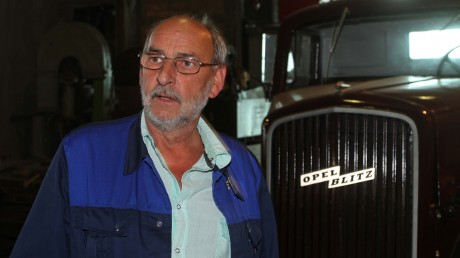
After all those years: Rüdiger Nausch worked long and hard in the steel plant in Brandenburg until its closure. He now works at the Museum of Industry and knows everything there is to know about the history of the neighboring Opel plant.
Rüdiger Nausch was a steelworker for many years and now guides visitors through the museum’s giant halls. “The Opel site is up for sale. It wasn’t expropriated during the GDR era. You know, Opel could have constructed a new plant here after reunification.” Nausch is well versed in the industrial history of the city on the Havel River and talks about the Brennabor brand that went bankrupt in 1933 and what happened to the Arado factories. “Today, ZF has 1,200 people working here manufacturing transmissions for the entire automotive industry.” This sector is also regaining a foothold in the newly developed recycling facility. The facility uses a new method to produce non-mixed plastic recyclates, which in turn are used in the manufacture of the ADAM and the Corsa in Eisenach. But Rüdiger Nausch has another surprise in store for the Omega. He walks further on into the dark halls of the former steel and rolling mill until finally, there it is: the last roadworthy Opel Blitz from the Silo Canal! It’s a brown three-ton model, restored by workers on employment schemes and financed by the museum’s booster club. For a moment, faced with its ancestor, the Omega looks well and truly devout. Two six-cylinder vehicles standing face to face. A giant flatbed here, an enormous station wagon tail there. The giant truck grill features ‘Opel Blitz’ lettering and Opel’s lightning bolt logo appears on the aerodynamic Omega.
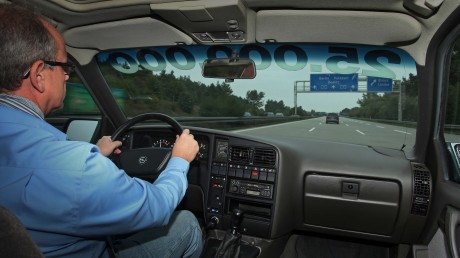
Heading for Berlin: The 25-year-old Opel Omega 3.0i, the 25 millionth Opel produced, offers impressive levels of comfort on the journey through time from Eisenach to the capital and still has enough life left in it for the fast lane.
Berlin, Berlin, We’re Off to Berlin
The journey to Berlin from Brandenburg an der Havel is short and takes you past Potsdam and Old Fritz, along Heer Strasse through Spandau and into the vibrant city. Visitors really have to look hard to find the last remnants of the divided Germany. The East Side Gallery and Checkpoint Charlie are far too touristy for the Omega after its long journey through time. Instead, the station wagon now drives towards its final destination: Bernauer Strasse. Here, the Iron Curtain brutally cut through the city, splitting homes right down the middle and dividing families into East and West Berliners. The street is still lined with the remains of the Berlin Wall in its original gray form without a trace of colorful graffiti. The rest of the route is marked by steel posts. The Berlin Wall Memorial building features rusting, blood-red steel walls and commemorates the estimated 138 victims of the Wall. The Omega makes a brief stop at a house with a mural that depicts the building of the Wall. Below it, smaller reproductions show endless convoys of Trabants at the border crossing at Bernauer Strasse and tearful scenes of jubilation in 1989. “My year of birth,” thinks the Omega proudly and sets off on its return journey towards Rüsselsheim.
1 millionth cars: Opel Kapitän (October 1940)
10 millionth cars: Opel Rekord C (September 1971)
25 millionth cars: Opel Omega A Caravan (February 1989)
30 millionth cars: Opel Omega B (April 1994)
50 millionth cars: Opel Omega „Executive“ (December 1999)
Opel has produced more than 67 million vehicles until today. 3 millions of them were produced in Eisenach. At 2,6 million, the Corsa has been the mostly produced car in Eisenach so far.